
The City Loop is a piece of underground commuter rail infrastructure in the central business district (CBD) of Melbourne, Victoria, Australia

Sunshine railway station is located on the Sunbury line in Victoria, Australia, serving the western Melbourne suburb of the same name.
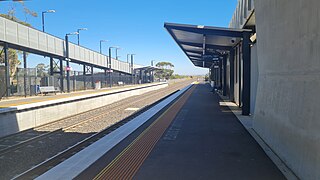
Rockbank railway station is located on the Serviceton line in Victoria, Australia. It serves the western Melbourne suburb of Rockbank, and opened on 2 April 1884 as Mount Atkinson. It was renamed Rockbank in November 1889.

Proposals for expansion of the Melbourne rail network are commonly presented by political parties, government agencies, industry organisations and public transport advocacy groups. The extensions proposed take a variety of forms: electrification of existing routes to incorporate them into the suburban rail system; reconstruction of former passenger rail lines along pre-existing easements; entirely new routes intended to serve new areas with heavy rail or provide alternative routes in congested areas; or track amplification along existing routes to provide segregation of services. Other proposals are for the construction of new or relocated stations on existing lines, to provide improved access to public transport services.
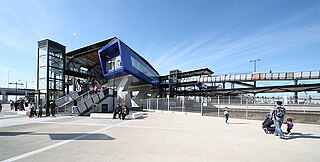
The Werribee line is a commuter railway line in the city of Melbourne, Victoria, Australia. Operated by Metro Trains Melbourne, it is the city's ninth longest metropolitan railway line at 32.9 kilometres (20.4 mi). The line runs from Flinders Street station in central Melbourne to Werribee station in the south west, serving 17 stations via Footscray, Newport, and Altona. The line operates for approximately 19 hours a day with 24 hour service available on Friday and Saturday nights. During peak hour, headways of up to 5–20 minutes are operated with services every 20–30 minutes during off-peak hours. Trains on the Werribee line run with a two three-car formations of Comeng, Siemens Nexas, and X'Trapolis 100 trainsets.
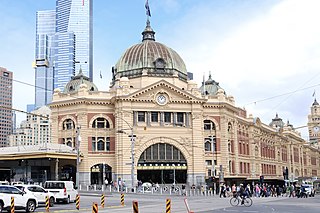
The Melbourne rail network is a metropolitan suburban and freight rail system serving the city of Melbourne, Victoria, Australia. The metropolitan rail network is centred around the Melbourne central business district (CBD) and consists of 221 railway stations across 16 lines, which served a patronage of 99.5 million over the year 2021–2022. It is the core of the larger Victorian railway network, with regional links to both intrastate and interstate rail systems.
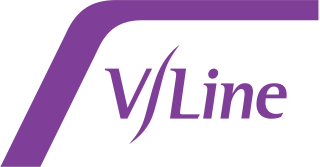
V/Line is a statutory authority that operates regional passenger train and coach services in the Australian state of Victoria. It provides passenger train services on five commuter lines and eight long-distance routes from its major hub at Southern Cross railway station in Melbourne. It also provides bus services across Victoria and into New South Wales, the Australian Capital Territory and South Australia. In addition, V/Line is responsible for the maintenance of much of the Victorian freight and passenger rail network outside of the areas managed by Metro Trains Melbourne and the Australian Rail Track Corporation.
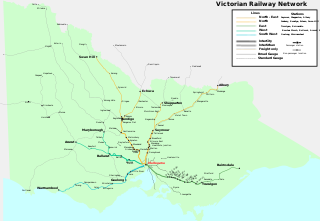
Rail transport in the Australian state of Victoria is provided by a number of railway operators who operate over the government-owned railway lines. The network consists of 2,357 km of Victorian broad gauge lines, and 1,912 km of standard gauge freight and interstate lines; the latter increasing with gauge conversion of the former. Historically, a few experimental 762 mm gauge lines were built, along with various private logging, mining and industrial railways. The rail network radiates from the state capital, Melbourne, with main interstate links to Sydney and to Adelaide, as well as major lines running to regional centres, upgraded as part of the Regional Fast Rail project.
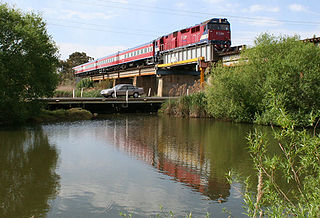
The Warrnambool line is a long-distance regional rail service in Victoria, Australia. Operated by V/Line, it is the state's fourth longest railway line at 267.3 kilometres (166.1 mi). The line runs from Southern Cross station in central Melbourne to Warrnambool station in the south-west, serving 21 stations via Wyndham Vale, Geelong, Waurn Ponds, and Colac. The line has five return services each weekday and three return services on weekends. Trains on the Warrnambool service run with three- to five-car N-class carriage sets, which are hauled by N class locomotives.
The Serviceton railway line is part of the Melbourne–Adelaide rail corridor. It serves the west of Victoria, linking the state capital of Melbourne to the cities of Ballarat and Ararat. It once extended to the disputed South Australian border as part of the Melbourne–Adelaide railway. The former broad-gauge track was replaced in 1995 by the 1435 mm Western standard gauge line.
The Geelong–Ballarat railway line is a broad-gauge railway in western Victoria, Australia between the cities of Geelong and Ballarat. Towns on the route include Bannockburn, Lethbridge, Meredith, Elaine and Lal Lal. Major traffic includes general freight from the Mildura line, and grain.

The Ballarat V/Line rail service is a regional passenger rail service operated by V/Line in Victoria, Australia. It serves passengers between state capital Melbourne and the regional city of Ballarat. Beyond Wendouree, it becomes the Ararat line and the Maryborough line.

The Metro Tunnel is a metropolitan heavy rail project currently under construction in Melbourne, Victoria, Australia. It includes the construction of twin 9-kilometre (5.6 mi) rail tunnels between South Kensington and South Yarra with five new underground stations. The tunnel will connect the Pakenham and Cranbourne lines with the Sunbury line, creating a new high-frequency cross-city line that bypasses Flinders Street station and the City Loop. The line is also planned to serve Melbourne Airport via a new branch line west of Sunshine.

The Network Development Plan – Metropolitan Rail was a long-term development plan for the rail network of Melbourne, Australia. It was written by Public Transport Victoria (PTV) and released to the public on 27 March 2013 under the Napthine government and received minor updates in 2016.
The Murray Basin Rail Project is a major railway project in the north-west of Victoria, Australia. The project includes the conversion of a substantial portion of the Victorian freight rail network from the historical broad gauge to the standard gauge used in other parts of Australia, and the upgrading of track to enable higher axle loads for more efficient intrastate freight transfer.
The Department of Transport and Planning (DTP) is a government department in Victoria, Australia. Commencing operation on 1 January 2019 as the Department of Transport (DOT), the DOT was formed in machinery of government changes made by Premier Daniel Andrews after the re-election of his Labor government at the 2018 Victorian state election. The re-shuffle saw the "super-ministry" Department of Economic Development, Jobs, Transport and Resources abolished and its functions reassigned to the DOT and Department of Jobs, Precincts and Regions.

The Western Rail Plan is a metropolitan rail infrastructure project being undertaken in Melbourne, Australia. The project was initially announced during the 2018 Victorian state election by the State Government. It includes the electrification of two currently existing regional lines to Melton and Wyndham Vale, and other network capacity upgrades.
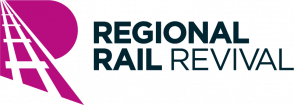
The Regional Rail Revival is a joint initiative between the Australian federal government and the Victorian state government to upgrade all regional railway lines in Victoria. The project has an estimated total cost of A$4 billion. A$2.3 billion of the project's total cost is being funded by the Australian Government. It was delivered by Rail Projects Victoria (RPV) until April 2024, and then by the Level Crossing Removal Project. The project is guided by the 2016 Regional Network Development Plan, which outlines the short, medium and long-term priorities for a modernised regional rail network.

The Regional Rail Link (RRL) was a project to build a 47.5-kilometre (29.5 mi) length of railway through the western suburbs of Melbourne, Victoria, the main aim of which was to separate regional V/Line Ballarat, Bendigo and Geelong services from the electrified Melbourne suburban services, thereby increasing rail capacity and reliability. The project involved the building of an extra pair of tracks from Southern Cross station to Sunshine, parallel to the Western line, and a new double-track line from Deer Park, which joins with the Warrnambool line west of Werribee, near the site of the former Manor railway station. New stations were built at Tarneit and Wyndham Vale, while West Footscray and Sunshine stations were rebuilt. Additional platforms were built at Southern Cross and Footscray stations, and two level crossings near Sunshine were replaced by grade separations. The most used station before its construction, North Melbourne, was excluded from the project despite being the main connection hub for regional travellers not needing to go all the way to Southern Cross, and now requires regional rail link customers to change at Footscray.















